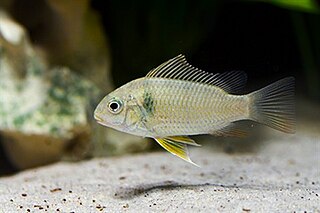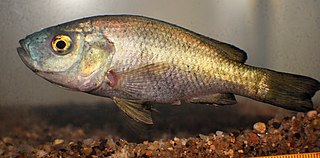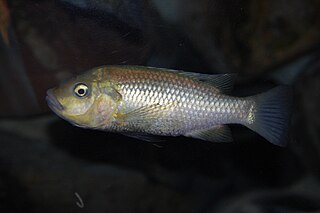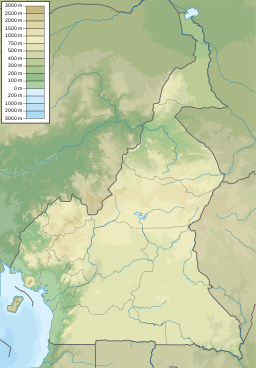
Etia nguti is a species of cichlid fish endemic to Cameroon in Central Africa where it is only known from the Nguti River, a tributary of the Cross-Manyu River. This species can reach up to 13.3 centimetres (5.2 in) in standard length. It is the only member of its genus and tribe.

Clarias maclareni is a critically endangered species of catfish in the family Clariidae. It is endemic to Lake Barombi Mbo in western Cameroon. It is currently threatened because of pollution and sedimentation due to human activities, and potentially also by large emissions of carbon dioxide (CO2) from the lake's bottom (compare Lake Nyos). It is known to grow to 36 centimetres (14 in) TL. Large individuals feed mainly on other fishes (especially cichlids), while smaller individuals mainly feed on insects.
The dikume is a critically endangered species of fish in the family Cichlidae. It is endemic to Lake Barombi Mbo in western Cameroon.

The konye (Konia eisentrauti) is a critically endangered species of fish in the family Cichlidae. It is endemic to Lake Barombi Mbo, a crater lake in western Cameroon. It is threatened because of pollution and sedimentation due to human activities, and potentially also by large emissions of carbon dioxide (CO2) from the lake's bottom (compare Lake Nyos). This species can reach a length of 9.3 centimetres (3.7 in) TL.

The myaka (Myaka myaka) is a critically endangered species of cichlid endemic to Lake Barombi Mbo in western Cameroon. It prefers open, deeper waters where it feeds on phytoplankton and small insects, only venturing into shallower waters to spawn. This species can reach a length of 6.7 centimetres (2.6 in) SL. It is currently the only known species in the genus Myaka, but it is very close to Sarotherodon. The myaka is threatened because of pollution and sedimentation due to human activities. It is potentially also threatened by large emissions of carbon dioxide (CO2) from the lake's bottom (compare Lake Nyos), although studies indicate that Barombo Mbo lacks excess amounts of this gas. Konia, Pungu and Stomatepia are three other equally threatened genera of cichlids that also are endemic to Lake Barombi Mbo.

The pungu is a species of cichlid endemic to Lake Barombi Mbo in Cameroon where it prefers shallow waters of about 1 to 3 metres in depth. It feeds on invertebrates, sponges, diatoms and macrophytes. This species can reach a length of 10 centimetres (3.9 in) SL. It is currently the only known member of its genus, nested within the Sarotherodon. The pungu is threatened because of pollution and sedimentation from human activities. Konia, Myaka and Stomatepia are three other equally threatened genera of cichlids that also are endemic to Lake Barombi Mbo. The specific name of this fish honours the Fisheries Development Officer of Nigeria, P.I.R. MacLaren, who used his position to collect specimens of fishes, including the type of this species. The genus name honors common name of this fish used by the Barombi people ("pungu").
The fissi (Sarotherodon caroli) is a species of cichlid endemic to Lake Barombi Mbo in western Cameroon. This species can reach a length of 18.6 centimetres (7.3 in) SL. It is threatened because of pollution and sedimentation due to human activities. It is potentially also threatened by large emissions of carbon dioxide (CO2) from the lake's bottom (compare Lake Nyos), although studies indicate that Barombo Mbo lacks excess amounts of this gas.
The leka keppe (Sarotherodon lohbergeri) or keppi, is a species of cichlid essentially endemic to Lake Barombi Mbo in western Cameroon, but additionally two juveniles have been found in the Kumba Stream (Kake River), a tributary of the lake's outlet. This species reaches a length of 16.2 centimetres (6.4 in) SL. It is threatened because of pollution and sedimentation due to human activities. It is potentially also threatened by large emissions of carbon dioxide (CO2) from the lake's bottom (compare Lake Nyos), although studies indicate that Barombo Mbo lacks excess amounts of this gas.
The kululu (Sarotherodon steinbachi) e.g. Vikululu - Nikululu - Akululu - Bokululu - Hekululu is a species of cichlid endemic to Lake Barombi Mbo in western Cameroon. This species can reach a length of 11.3 centimetres (4.4 in) SL. It is threatened because of pollution and sedimentation due to human activities. It is potentially also threatened by large emissions of carbon dioxide (CO2) from the lake's bottom (compare Lake Nyos), although studies indicate that Barombo Mbo lacks excess amounts of this gas.

The nsess (Stomatepia mariae) is a species of cichlid endemic to Lake Barombi Mbo in western Cameroon. It can also be found in the aquarium trade. It is critically endangered because of pollution and sedimentation due to human activities. It is potentially also threatened by large emissions of carbon dioxide (CO2) from the lake's bottom (compare Lake Nyos), although studies indicate that Barombo Mbo lacks excess amounts of this gas.

Stomatepia is a genus of cichlids endemic to Lake Barombi Mbo in western Cameroon. Although generally recognized as distinct, the genus is very close to Sarotherodon. The Stomatepia species are all recognized as critically endangered by the IUCN because of pollution and sedimentation due to human activities. They are potentially also threatened by large emissions of carbon dioxide (CO2) from the lake's bottom (compare Lake Nyos), although studies indicate that Barombo Mbo lacks excess amounts of this gas. Konia, Myaka and Pungu are three other equally threatened genera of cichlids that also are endemic to Lake Barombi Mbo.

The pindu is a critically endangered species of cichlid endemic to Lake Barombi Mbo in western Cameroon.

Coptodon deckerti is a critically endangered species of fish in the cichlid family, endemic to Lake Ejagham in western Cameroon. It is threatened by pollution and sedimentation from human activities, and potentially also by emissions of carbon dioxide (CO2) from the lake's bottom (compare Lake Nyos), although Ejagham is too shallow to contain very high amounts of this gas. A species of catfish from the genus Parauchenoglanis has recently been introduced to the lake, and this probably presents a serious threat to the endemic cichlids.

Coptodon kottae is an endangered species of fish in the cichlid family, Cichlidae. It is endemic to Lake Barombi-ba-Kotto and the smaller nearby Lake Mboandong in the Southwest Region of Cameroon.
Stomatepia mongo, the mongo, is a species of cichlid endemic to Lake Barombi Mbo in western Cameroon. It can reach a length of 10.3 centimetres (4.1 in) SL. This species is seriously threatened by pollution and sedimentation due to human activities. It is potentially also threatened by large emissions of carbon dioxide (CO2) from the lake's bottom (compare Lake Nyos), although studies indicate that Barombo Mbo lacks excess amounts of this gas. Even compared to other cichlids that are endemic Lake Barombi Mbo, Stomatepia mongo is a very rare species.
Konia is a small genus of critically endangered cichlids endemic to Lake Barombi Mbo in western Cameroon. Although generally recognized as distinct, the genus is very close to Sarotherodon. The Konia species are threatened because of pollution and sedimentation due to human activities. They are potentially also threatened by large emissions of carbon dioxide (CO2) from the lake's bottom (compare Lake Nyos), although studies indicate that Barombo Mbo lacks excess amounts of this gas. Myaka, Pungu and Stomatepia are three other equally threatened genera of cichlids that also are endemic to Lake Barombi Mbo.

Sarotherodon linnellii, sometimes known as the unga, blackfin tilapia or blackbelly tilapia, is a cichlid endemic to Lake Barombi Mbo in western Cameroon. This species reaches a length of 18.5 centimetres (7.3 in) SL. It is critically endangered because of pollution and sedimentation due to human activities. It is potentially also threatened by large emissions of carbon dioxide (CO2) from the lake's bottom (compare Lake Nyos), although studies indicate that Barombo Mbo lacks excess amounts of this gas.
Lake Bermin is a small lake in the volcanic chain in the Southwest Region of Cameroon. It is a volcanic lake with a diameter of about 700 m (2,300 ft) and a crater rim that rises to a height of about 46 m (150 ft). This highly isolated lake is roughly circular in shape, lacks an inflow, but has an outflow into the Cross River system.
Lake Ejagham is a small lake near Eyumodjock in the Southwest Region of Cameroon. Unlike many other lakes in the region, it is not a volcanic lake, but is likely a solution basin formed by groundwater during the last Ice Age. This highly isolated lake is roughly oval in shape, lacks an inflow, but has an outflow into the Munaya River. The outflow is impassable to most fishes because of a waterfall.

Lake Barombi Koto, also known as Lake Barombi Kotto or Lake Barombi-ba-Kotto, is a small lake in the volcanic chain in the Southwest Region of Cameroon. It is a volcanic lake with a diameter of about 1.2 km (0.75 mi). There is a small island in the middle, which is densely inhabited by the Barombi, a tribe of fishers. The Tung Nsuia and Tung Nsuria streams, each about 1–2 m wide and 0.3 m deep near their mouth, are the only inflows into the lake, and they dry out in dry season.




















